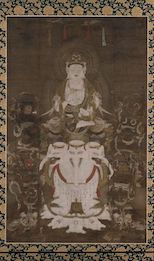Jodo Wasan 17
The countless great bodhisattvas of the land of happiness,
Have reached 'succession to Buddhahood after one lifetime';
Entering the compassionate activity of Samantabhadra,
They unfailingly work to save beings in defiled worlds.
A Model Bodhisattva
Bodhisattva: Beings whose aspiration, like that of Shakyamuni Buddha before his enlightenment, is to become a Buddha in order to transcend the realm of birth-and-death for their own benefit and that of others.
The Buddha said to Ananda, 'The bodhisattvas of that land all fulfil the attainment of Buddhahood after one lifetime, except those who, for the sake of sentient beings, have established their own original vows and, thus adorning themselves with the virtues of universal vows, seek to bring all to emancipation.'1
There are two kinds of bodhisattvas: those who seek simply to become Buddhas like Shakyamuni and intend principally to teach the Four Noble Truths and the Noble Eightfold Path, or those who, like Amida, resolve to actively cultivate merit which they transfer for the purpose of saving all sentient beings, irrespective of beings' capacity to practice the precepts and live a monastic life.

As Shinran makes clear in this verse, Samantabhadra Bodhisattva (fugen bosatsu) is a hero. He is the perfect example of a bodhisattva who sets out to acheive universal salvation. As the sutra Vows of Virtuous Conduct makes clear, the bodhisattva seeks nothing less than full realization of a universe of totally interdependent phenomena which manifest Buddha. Either that, or - as a means to this realization - birth in Amida's Pure Land. That is why Shinran insists - over and over again - that the goal of birth in the Pure Land (oso) is return (genso) to the sphere of samsara. All existing things are integral to the whole and the whole is contained in the parts. The Pure Land is a clearing house for full integration into the whole and saving participation within it.
Samantabhadra is famous for ten vows which exemplify the universally oriented bodhisattva. They include the embracing of all universes, the development of power to help all beings and the sheltering of all sentient beings, in short, becoming one with all and a refuge for all. Surely no religious teaching has accomplished such monumental heights of compassionate insight and heart wrenching love of beings - and it is this ethos to which the Pure Land tradition belongs. On 'this side' of the Pure Land we remain unenlightened recipients of this great compassionate work. Amida's shinjin surely prompts within us the longing to become a part of the saving universal whole.
The Sutra of Meditation on the Bodhisattva Universal Virtue tells us that Bodhisattva Samantabhadra rides upon an elephant with six tusks and seven legs. He has conquered the things which this elephant represents:
- the heavy burden of karmic evil,
- six tusks suggest the six sense organs2 which play a role as the vehicle of karmic trouble,
- and the seven legs of the elephant suggest the burden imposed by the seven elements of evil.3
Samantabhadra represents the ultimate aspirations of those of us who are on the Jodo Shinshu way.
1: TPLS II, pp. 59f.
2: The six sense organs are: eyes, ears, nose, tongue, body, and mind.
3: The seven elements of evil are the opposite of the seven elements of virtue, which are faith, repentance, shamefulness, hearing the dharma, efforts, mindfulness and wisdom.